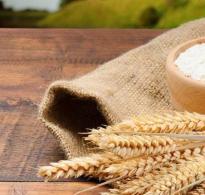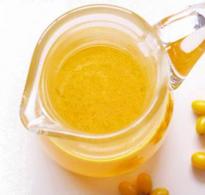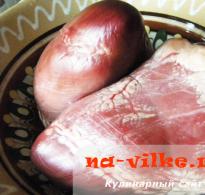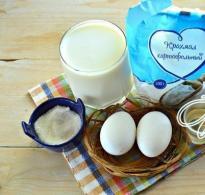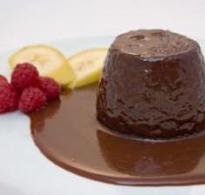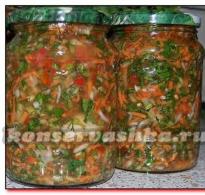Millet porridge for children. Semolina porridge with milk
It's no secret that a child's diet should be rational and varied. Nutrition is the key to the proper development and growth of the baby. Porridge is the basis of the diet of children from 6 months and older. In cases where a child lags behind in weight gain, porridge is introduced into complementary foods first. Rice, corn, buckwheat, millet - all these porridges have firmly entered the menu of children in our country. Today we will prepare milk millet porridge.
The benefits of millet porridge with milk for a child
It’s not for nothing that millet porridge is one of the most popular dishes. “Golden groats” is what our ancestors called millet. This name is fully justified by the large amount of vitamins, minerals, high energy value and, of course, the yellow color of the cereal.
- With all these advantages, millet is affordable. So, what exactly are the vitamins and minerals found in millet?
- Millet contains a lot of B vitamins. They maintain healthy hair and skin, are necessary for the body’s muscle tissue, and are responsible for the stability of the nervous system and good sleep.
- Vitamins E and A provide visual acuity, prevent fatigue, have a beneficial effect on the functioning of the liver, respiratory tract and thyroid gland.
- Minerals potassium, magnesium, calcium, phosphorus are needed for the cardiovascular and skeletal systems, iron regulates hematopoiesis and, zinc helps the liver, iodine is necessary for the endocrine system, copper prevents and.
- Fiber promotes good functioning of the gastrointestinal tract, improving digestion.
- Millet is easily absorbed by the body and is a hypoallergenic grain that does not contain gluten. It is useful for people with diseases of the pancreas, liver, and diabetes. Millet removes toxins from the body and is especially important to use after taking antibiotics.

Millet is introduced into a baby's diet after rice and corn cereals, usually at 8-9 months.
The introduction occurs gradually, starting with 3-5 grams of porridge. The first porridge is prepared from millet flour and water. The finished porridge is diluted with breast milk or the formula that the artificial baby eats.
Millet flour is obtained by grinding whole millet in a coffee grinder. By 11 months, the grinding can be coarser. And from 14-16 months you can cook whole millet.
As always, when introducing a new product, it is advisable to give millet porridge in the morning, after feeding. This is necessary to monitor a possible allergic reaction, although allergies to millet are very rare. In the absence of allergic manifestations, increase the amount of porridge, bringing it to the serving size.
Children 10-12 months old can use cow's milk to prepare millet porridge. When purchasing milk, give preference to special baby milk. Even in the first few doses it is recommended to dilute it with water in a 1:1 ratio.

To prepare delicious millet porridge with milk, it is important to choose the right millet:
- choose hermetically sealed millet;
- make sure there is no debris;
- the color of the millet should be dull and yellow;
- Pay attention to expiration dates - old millet is bitter.
Do not buy millet for future use. During storage, fats oxidize and taste deteriorates.
Millet porridge with milk - recipe
Millet porridge with milk will turn out tasty if you carefully follow the proportions: the volume of cereal to liquid should be 1 to 4.
Required Ingredients
- millet – 100 grams;
- water – 200 ml;
- milk – 200 ml;
- butter – 25 grams;
- flavor enhancers (salt, sugar) - to taste.
Cooking sequence

To improve the taste, berries, fruit puree or pieces of fruit, and jam are added to the porridge.
Millet porridge with milk in a slow cooker
Required Ingredients
- 1 measure of cereal;
- add sugar and salt to taste;
- 4 measures of milk;
- butter – 30-40 grams.
The healthiest millet porridge will come from millet with a bright yellow grain color. But unlike other cereals, millet is not stored for a long time due to its higher fat content, which quickly oxidizes. Therefore, it is better not to let it sit too long; in addition to porridge, you can make pancakes and casseroles from millet.
Millet porridge for children is useful primarily because it is able to remove toxins and antibiotics from the body, and has a beneficial effect on the hematopoietic system, liver and cardiovascular system. Millet millet contains vitamins PP (niacin equivalent), Beta-carotene, A (RE), B1 (thiamine), B2 (riboflavin), B6 (pyridoxine), B9 (folic acid), E (TE), as well as a large supply trace elements: potassium, phosphorus, sulfur, chlorine, calcium, magnesium, copper, sodium, zinc, iron, chromium, iodine, manganese, boron, molybdenum, fluorine, aluminum, tin, cobalt, titanium, etc.
Millet porridge made from whole grains is not recommended for children under one year of age due to the difficulty of digesting it, but prepared from millet flour will be useful. Millet porridge can be bought in the baby food department; the main thing here is to pay attention to the recommendations regarding the baby’s age: the smaller the child, the higher the degree of grinding should be. From 8-9 months, a child can be given millet porridge prepared only from millet flour. You can buy it or prepare it yourself. It will be convenient to grind a portion of millet, intended for a week or two, in a coffee grinder and pour it into a jar, and then prepare the porridge as needed. Before grinding, the millet must be thoroughly washed and dried. Whole grain porridge is best given from 1.5 years of age.
For babies, millet porridge should be given with 1 teaspoon, and if no problems arise (stool problems, constipation, allergic reactions), then the next day you can give 2-3 spoons, and so gradually increase the portion to 200 g. Cereal porridge must be present in a child’s diet from 8 months, but it’s better to start with buckwheat, oatmeal or rice, and only then try millet. There is no need to feed your child the same type of porridge every day; they are all healthy in their own way. It will be better to alternate cereals with each other.
How to cook millet porridge for a child? There are different ways, the recipe must be chosen based on the child’s age and taste preferences.
Millet porridge recipes:
- Child up to one year old. Add 10 g of millet flour to boiling water (100-150 ml) and cook for 3 minutes. After the porridge has cooled a little, you can add fruits and berries that have already been introduced into the child’s diet, for example, grated apple, peach, apricot, banana, red currant.
- Child after one year. Pour 0.5 cups of millet flour (coarser grinding possible) into 200 ml of milk and cook over low heat until tender. The duration of cooking will depend on the degree of grinding of the millet. After cooking, you can add a little sugar, fruit, berries or dried fruits to the porridge.
- Child over 1.5 years old. Pour 0.5 cups of millet into 250 ml of milk, add chopped apple, pear or pumpkin and cook until tender. At the end of cooking, you can add dried fruits and a little sugar.
Wheat porridge for a child will be no less useful. It is not so rich in vitamins and microelements, but, for example, it contains more iron, potassium and phosphorus. You need to introduce wheat porridge into your child’s diet like any other, the main thing is to start with a small portion and carefully observe the baby’s reactions. Just like millet, wheat porridge for a child aged 8 months should be prepared from finely ground wheat cereal or from a ready-made mixture purchased in the baby food department.
How to cook wheat porridge for a child? Let's look at several recipes for children of different ages:
- Child up to one year old. Add 10 g of finely ground wheat cereal to 100 ml of boiling water and cook for 5 minutes. After the porridge has cooled a little, add grated apple, peach, apricot, banana or red currant. If the child agrees to eat without sugar, it is better not to add it.
- Child after one year. Pour 0.5 cups of wheat cereal into 200 ml of milk and cook over low heat until tender. After cooking, you can add a little sugar, 3 g of butter, fruits, berries or dried fruits to the porridge.
- Child after one year. Pour 0.5 cups of wheat cereal into 200 ml of water or broth, add a pinch of salt and cook over low heat until tender. After cooking, add 3 g of butter and a steamed meat or fish cutlet to the porridge.
First, it is better to offer your child porridge without salt and sugar, and if he agrees to eat, then such porridge will be more healthy. Otherwise, you can add a little salt or sugar, but for you the porridge should be under-salted or not particularly sweet.
Millet does not grow as an independent crop. It is a secondary product after purification of millet, which our distant ancestors ate with great eagerness, because they clearly understood the value of this product.
Today millet is one of the cheapest cereals, but this does not diminish its advantages.
Millet is another grain that has undeservedly been forced out of the “bins” of modern housewives by other products. Perhaps due to the fact that it gives an irritating bitterness, overcooks or, on the contrary, becomes unpleasantly hard...

But all these are just the consequences of improper handling of cereals. After all, if you know a good step-by-step recipe on how to properly cook millet porridge with milk, you can get an excellent dish.

 Millet porridge is not inferior to others in terms of its enormous content of microelements and vitamins. In cereals you can find vitamin B2, which promotes hair growth, strong nails and improved skin condition.
Millet porridge is not inferior to others in terms of its enormous content of microelements and vitamins. In cereals you can find vitamin B2, which promotes hair growth, strong nails and improved skin condition.
You can also note the presence of iron and calcium, which are responsible for the good condition of the skeletal system.
In addition, millet porridge is not an allergenic product, and therefore it can be safely included in the diet of people suffering from food allergies or diseases of the gastrointestinal tract, and it is also ideal for small children.
But for those who are overweight, there is only one drawback to this porridge - it is very high in calories. Therefore, you should not abuse it, but only occasionally indulge yourself with a variety of flavors, provided that you know how to cook millet porridge with milk.
Subtleties in cooking
In order for millet porridge for breakfast to charge you with energy, give you strength, and most importantly give you pleasure, you must follow a few generally accepted rules:
- Millet should be washed “in seven waters”, and the penultimate one should be hot, and before cooking, the cereal should be doused with boiling water, this will help get rid of the bitterness that is present in the grains. It is better to do this through a fine sieve, then the water will drain completely and not a single grain will be lost.
- Proportions must be observed. Initially, you need to pour a lot of water into the cereal, but after the cereal has boiled until half cooked in a few minutes, this water will have to be drained. This is another way to remove bitterness from cereals.
- The milk must be added hot so that the cereal, while languishing in it, opens up and becomes softer.
- To appreciate all the benefits of millet, it should be prepared using different recipes, ingredients and cooking methods.
Millet should not be stored in the sun, otherwise it will lose all its taste and become sour. Before purchasing, be sure to check the expiration date; expired grains will certainly add additional bitterness to the grain.
One of the most common and most used is the classic recipe for making milk porridge. To do this you will need:
- one glass of millet;
- 30 gr. butter;
- two glasses of milk;
- two tablespoons of sugar;
- two glasses of water;
- a pinch of salt.
 First you need to prepare the cereal. Rinse it in several waters until the liquid becomes clear. Then pour boiling water over the millet. After this, pour it with plenty of water and put it on the fire, which after boiling, reduce it.
First you need to prepare the cereal. Rinse it in several waters until the liquid becomes clear. Then pour boiling water over the millet. After this, pour it with plenty of water and put it on the fire, which after boiling, reduce it.
How long does it take to cook porridge in water? The answer is simple - until half cooked, it all depends on the intensity of the fire and the quality of the cereal.
After this, the liquid is drained, and the cereal is poured with hot milk, butter and sugar are added. Next, the porridge is cooked until completely cooked, approximately 20 minutes.
The ideal option would be to then place the container with the finished porridge in a preheated oven for a few minutes so that it completely steams and the grains open.
If you need to cook liquid porridge for a child, then you should choose yellow cereal, and if the child wants crumbly millet, then it is more advisable to choose dark-colored grain and, of course, control the amount of water and milk.
Millet from a slow cooker
Cooking in helps not only save cooking time, but also relieves the housewife from constantly monitoring to ensure that the porridge does not burn. If you choose the most suitable recipe, then you can quickly, easily, and most importantly deliciously prepare not only millet, but also rice porridge. If you have previously cooked only on the stove, you will be able to appreciate the process of cooking in a slow cooker.
Ingredients you will need: one glass of cereal, twice as much water, about 30 grams of butter, salt, sugar as desired.
Initially, the cereal must be sorted and washed thoroughly. Place the prepared millet in a bowl, add water, add salt and sugar, close the lid. How long does it take to cook millet porridge in a slow cooker?
It all depends on the model of the equipment, but generally in the “Porridge” mode it will take about 20 minutes. After cooking the porridge, you should open the lid, mix everything thoroughly, you can add a little more oil, close it again and let it sit for a few more minutes.
With pumpkin
You can diversify the classic recipe using pumpkin by adding it to the porridge during cooking. Pumpkin goes well with millet, giving it a soft, sweet taste. For this you will need: half a kilo of pumpkin, one glass of cereal, three glasses of water, 30-50 grams. butter and, of course, salt and sugar.
The pumpkin must be peeled and finely chopped, preferably into cubes. Heat the milk, add chopped pumpkin, salt and sugar. Bring to a boil. After this, pour the prepared millet into the pumpkin-milk mixture. Cook over low heat for half an hour. Then move the container with the porridge into the preheated oven and simmer for another forty minutes.
This is how you can easily and simply cook one of the healthiest and most delicious porridges - millet. And the presented video and photo will undoubtedly help with this.
Many people mistakenly believe that millet and wheat are the same thing. However, millet groats are actually millet seeds. Since this product has a large amount of useful vitamins and microelements, and is also less likely than others to cause an allergic reaction, millet porridge is often used as baby food. In this article we will look at the benefits it brings to the child's body, possible contraindications and recipes for preparing millet porridge.
Features of millet cereals
As a rule, all cereals place a significant burden on the digestive system, but not millet cereals. It is this property that explains the addition of this product to the diet of people with stomach diseases. Most of the composition of millet is starch. It is about seventy percent, which includes fifteen percent protein and vital amino acids (valine, leine, lysine). The fat content of millet cereals can vary from two and a half to three percent. Sugar takes up only two percent.

Among microelements, a significant silicon content can be noted. This substance is extremely useful and necessary for the proper development of human bones and skeleton, especially for the small growing body of a child. Phosphorus, present in millet, enhances the effect of silicon and promotes brain activity. It also plays an important role in strengthening the heart and the walls of blood vessels. Thanks to the B complex of vitamins, the brain is activated, the immune system is strengthened and carbohydrate metabolism is stimulated. In terms of fat content, millet groats are significantly inferior to oat groats. The amount of protein in millet is greater than in the same porridges made from rice or barley. There is much more vitamin B9 contained in millet porridge than in porridges made from corn or wheat groats. Also, millet is extremely necessary for iodine deficiency in the body or diseases of the thyroid gland. The composition of millet is also rich in zinc, sodium and bromine.
For infants - children 1 and 2 years old, such porridge is undesirable.
For a one-year-old child, it is, first of all, tasteless, and allergies can also occur.
Benefits and contraindications
First of all, millet porridge is healthy for babies due to its rich protein and amino acid content. It is thanks to them that intensive development of muscle fibers occurs, as well as strengthening of bones and skeleton. The presence of fiber in the composition helps to cope with constipation in the baby. Millet, from which millet cereal is produced, has special substances that help remove antibodies from the body that form during the course of any disease. In this regard, doctors introduce this product into the diet of a sick baby. Millet porridge is a kind of additional remedy in treatment, where antibiotics are already involved. This type of cereal helps, does not reduce the effect of the medicine, but also does not allow excess toxic substances to accumulate in the body. The great benefits brought by the consumption of millet are explained by the presence of the lipotropic effect that it has on the human body.

The beneficial properties of millet are as follows:
- it helps remove excess fluid and relieve swelling;
- has a diuretic effect on the human body (it is recommended to use it in the presence of a disease such as dropsy);
- if an inflammatory process occurs in the pancreas, it is necessary to consume millet at least once a day;
- promotes healing of injured bone, cartilage tissue and various wounds;
- the condition of the skin improves if you add millet to the diet (this is due to the rich content of vitamins and minerals, and the skin acquires firmness, elasticity, and resistance to various types of inflammation);
- the presence of a vitamin B complex in millet cereals helps reduce the nervousness and temper of a restless child;
- that with regular consumption of millet, the baby develops an appetite (this has been noted by many parents);
- millet is a rich source of microelements such as iron;
- its excellent compatibility with the group of B vitamins improves the process of hematopoiesis in the human body;
- copes well with removing poisonous and toxic elements (heavy metal ions) from the body.

As mentioned earlier, cereals are a fairly common cause of allergic reactions. Millet is the weakest allergen of all possible cereals used for making porridges. As a rule, an allergic reaction occurs exclusively in children. This is due to the fact that the baby’s digestive organs are not yet strong enough.
You will learn more about at what age you can introduce millet porridge into your baby's complementary foods below.

Introducing millet porridge into baby's complementary foods
Experts recommend that parents of their baby introduce millet porridge into complementary foods after he has been taught to eat buckwheat or rice porridge. A baby on artificial nutrition can start eating millet porridge as early as the seventh or eighth month. With natural nutrition, it is recommended to introduce millet from eight months to nine months of age. Despite the fact that millet cereal rarely causes an allergic reaction in a child, it is still advisable that the first serving should be no more than one tablespoon. Later, the portion of millet must be increased, naturally, in the absence of any unpleasant reaction from the child’s body. Ultimately, you should get a portion, the volume of which will be one hundred and fifty to one hundred and seventy grams per meal.

There are several tips regarding introducing this product into a baby's complementary feeding:
- For the first tasting, it is advisable to cook the millet porridge so that it has a liquid consistency. To do this, increase the volume of water or baby formula.
- It is recommended to serve millet for breakfast for the first time. This way you will have the opportunity to observe the body’s reaction to this product throughout the day.
- In the absence of an allergic reaction, the portion of millet porridge should approximately double with each meal.
- In order to diversify your child’s diet, cook soup from millet instead of porridge.

When the child turns two years old, boiled pumpkin, prunes or various fruits can be added to the millet. And make a delicious casserole from millet. For an eight- to ten-month-old baby, it is recommended to first grind the millet cereal before cooking. To do this, use a coffee grinder.
For older children, it is permissible to cook porridge from larger millet. However, whole millet grains are acceptable for children over one year of age.

Preparation
For the traditional recipe for preparing millet, you need to acquire: two hundred grams of cereal, thirty grams of cold-pressed vegetable oil, four hundred low-fat milk, two tablespoons of granulated sugar (or honey), four hundred milliliters of boiled water and a pinch of salt.


The algorithm for preparing millet is as follows:
- The cereal is thoroughly washed two to three times in water until the water becomes clear. Since millet cereals tend to have a bitter taste, before cooking, it is advisable to soak them for thirty minutes in cold water. This will get rid of the unpleasant taste. Next, the cleaned millet is poured into a pan with a tight bottom and filled with water. The power of the burner should be medium.
- When the water boils, you will need to remove the resulting foam and reduce the power of the burner. Continue cooking the millet until the water begins to evaporate.
- Meanwhile, boil the milk separately and pour it into the porridge being prepared in a small stream. Reduce heat again.
- Before the cereal has time to swell, add salt and granulated sugar (or honey). The cooked porridge becomes very thick, so it is necessary to sweeten the dish in advance.
- Then remove the pan from the stove and season with vegetable oil, since millet tends to have a dry texture.
When preparing millet for a baby less than one year old, you will need to almost double the volume of milk used, or reduce the amount of millet.
During the cooking process, regularly stir the contents of the pan, this way you will avoid burning the cereal towards its walls.



In order to diversify your baby’s diet, try preparing a tasty and healthy soup for him using millet and vegetable broth. Ingredients you will need to get: three medium-sized potatoes, small carrots, parsley, two hundred milliliters of milk, one tablespoon of millet, dill, a pinch of salt and twenty grams of low-fat sour cream.
To obtain a delicious soup, you must strictly follow the sequence of the following steps:
- Millet cereals are washed and poured into a pan. Then water is poured in. You must wait until the water boils.
- Meanwhile, in a slightly larger saucepan, you need to cook pre-finely chopped vegetables. To make the broth richer, it is advisable to take a smaller volume of water so that it barely covers the vegetables.
- Then the boiled vegetables and millet are poured into a mixer bowl and thoroughly crushed until a puree consistency is obtained.

Another tasty and healthy option involves adding pumpkin to millet porridge. The ingredients you will need are one hundred and fifty grams of pumpkin, a tablespoon of butter, a pinch of salt, two hundred milliliters of milk (or water), half a glass of millet. First, do not forget to thoroughly rinse the cereal and vegetables. Then the pumpkin is cut into small cubes and placed together with the millet in a pan. The contents are filled with water (or milk) and brought to a boil.
As in the first recipe, you will need to remove the resulting foam and add a pinch of salt. Then you need to wait until all the liquid has evaporated. After which you can add pre-boiled milk, it should be hot. Be sure to cover the pan with a lid and leave the contents to simmer for the next ten to fifteen minutes. Before feeding your baby, it is advisable to season the millet with a spoon of butter. The porridge will be delicious and nutritious!
You will learn more about how to prepare millet porridge from the following video.

